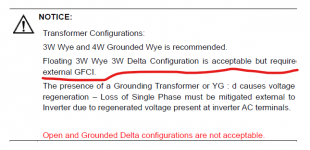wwhitney
Senior Member
- Location
- Berkeley, CA
- Occupation
- Retired
A quick scan of UL 1741 suggests that the answer would lie in IEEE 1547, which UL 1741 references. The IEEE standard, unfortunately, does not appear to be freely available.So the next question would be whether UL 1741 permits such an inverter.
Cheers, Wayne





